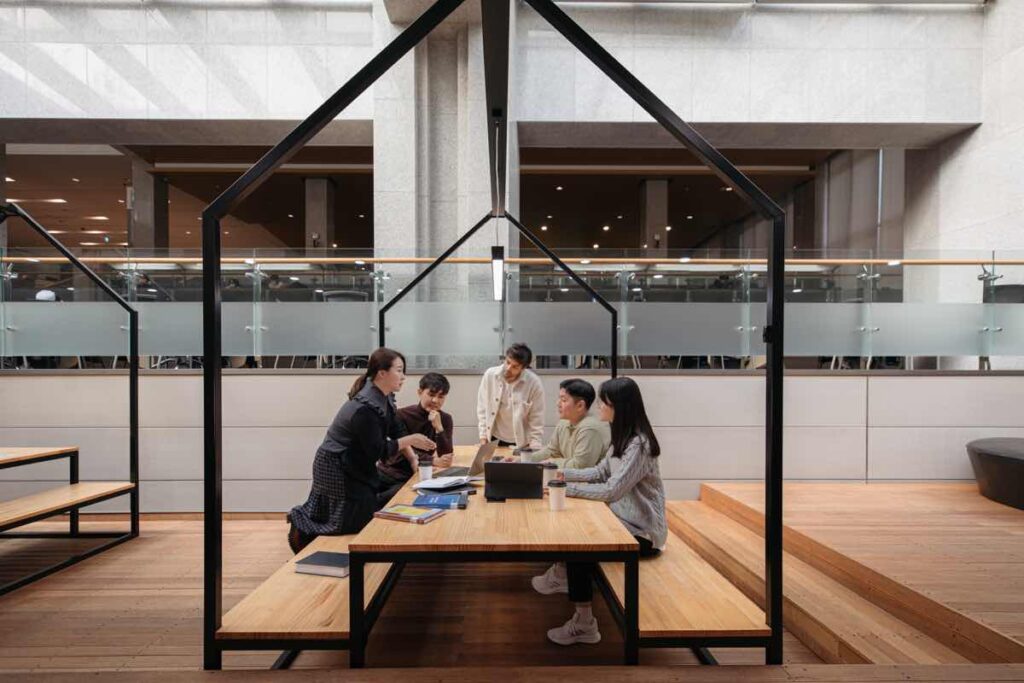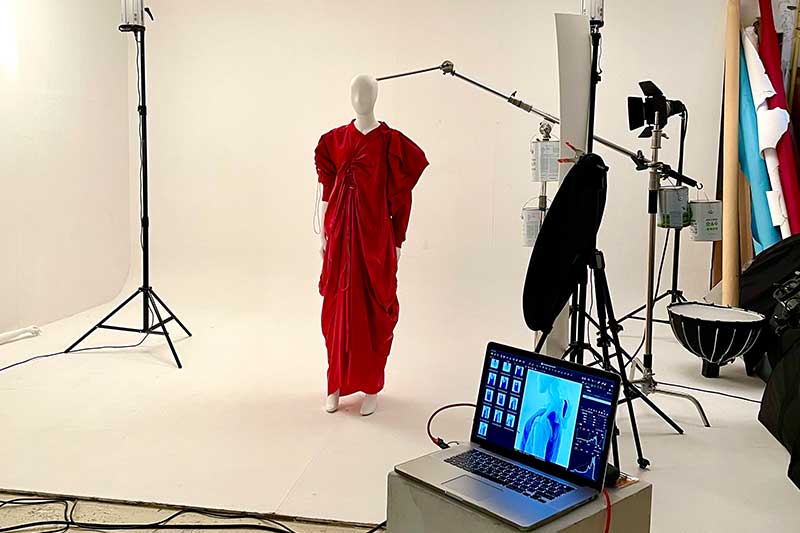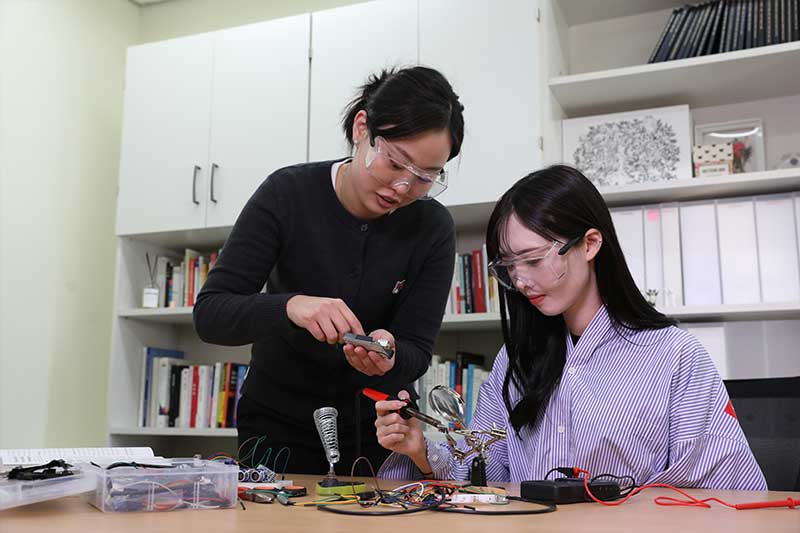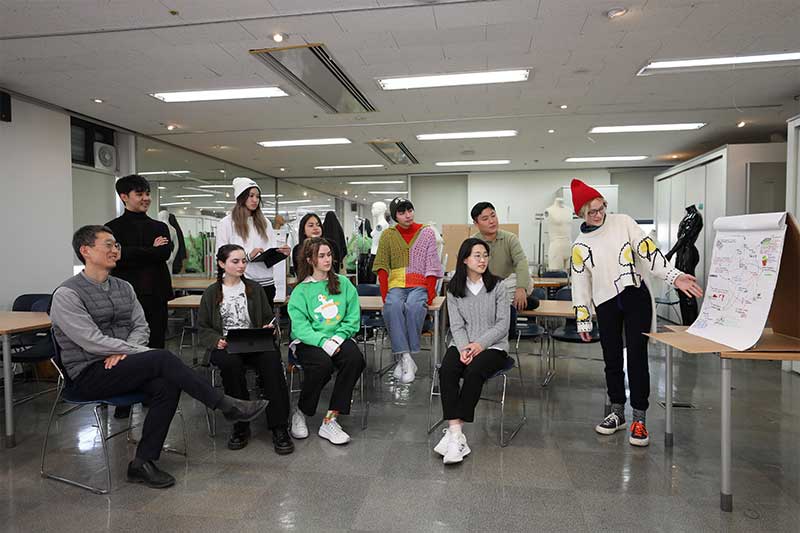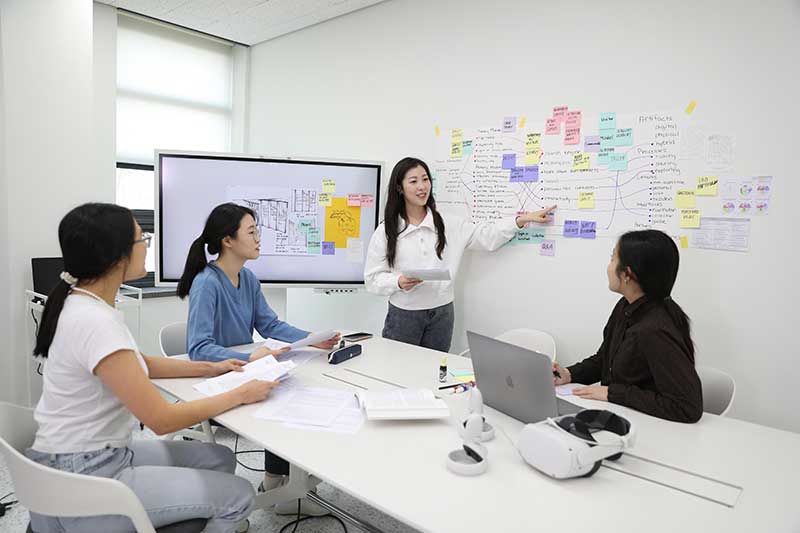
Undergraduate
The Department of Integrated Design offers a unique curriculum based on the integration of communication design (C), fashion design (F), and product design (P). We also offer modules to help students integrate their design practise through new media and technology, service/system design, design management, and design innovation, among others.
The curriculum of the Integrated Design programme begins in the first year with an emphasis on comprehending the notion of integrated design, examining the principles of design and media, and nurturing the mental agility and spirit of inquiry that professional designers should possess. In the second year, students study and gain expertise in numerous design domains through exploring integrated theory and design research, and technology, while concentrating on their particular area of expertise within the scope of integrated design. The third year of the curriculum consists of courses that deepen students’ knowledge of their chosen specialism while exposing them to integrated design processes and methodologies, allowing them to mature into more integrated professionals. The fourth year of the curriculum is intended to help students develop into integrated design professionals with practical leadership skills by providing project-based teaching contents that incorporates advanced design competencies and integrated design approaches, as well as the practical coursework required for starting a business or entering related industries after graduation.
In addition to providing integrated and interdisciplinary competencies, the Department of Integrated Design offers a tailored curriculum that allows students to develop professional expertise in specific domain within communication design, fashion design, product design, and AI-based integrated design.


Undergraduate Courses
Major Foundation
Observation & Expression
Teaches basic skills for analyzing subjects by identifying their characteristics, expressing them visually, and conducting various modeling activities based on those observations.
Major Required
Data-based Integrated Design Research
–
Design for X 1/2/3
–
Integrated Design Project
–
Introduction to Design
Teaches basic design theories, characteristics of various design fields, and modern design trends to broaden students’ understanding of human-oriented design.
Major Elective
This course teaches how to plan, visually express, and deliver public service and commercial advertisements by analyzing real-world examples and develops students’ strategic planning and visual expression abilities to enable them to deliver advertisement messages by teaching them about the characteristics of contemporary advertising media and practices related to each medium.
In this foundational communication design course, students will explore design elements and principles while actually engaging in comprehensive communication design exercises and projects to convey ideas and information using words and images.
Teaches basic fashion design skills through studies on foundational fashion design theories and concepts, such as how to make patterns and choose fabrics and supporting materials, techniques needed to make clothes, and how to develop and produce creative fashion designs.
Teaches basic product design techniques by having students designing various products based on product design principles and consumer wants and needs.
This course teaches about brand and communication design and how to design identities for precise brand communication through theory and practice, including developing new brands based on real-world social needs research.
This is a comprehensive communication design course in which students will freely conduct creative design projects involving visual image integration to grow their portfolios to support them in their future professions.
Teaches how aesthetic concepts are formed by social and cultural factors to enable students to understand and evaluate design.
Teaches students through theory and case studies how to identify business opportunities as designers based on an understanding of the overall business environment and how to develop design, marketing, and business strategies around them.
Introduces how design helps create a sustainable society by examining the unsustainable cultures and activities of contemporary societies, exploring the cases of sustainable design, and presenting design interventions that deal with the social and environmental problems.
Students work in major-related businesses during vacation periods to link their academic studies with real-world applications.
This course introduces a diverse range of design materials and explores concepts of form and surface through hands-on experimental projects engaging various materials. In-depth discussion about students’ work, including concepts, materials, form, and technical choices, is integral to the course.
Teaches about the entire design planning process, from idea development to commercialization, and related methods to teach students the innovative design planning skills they need to engage in integrated design.
Explores contemporary paradigms and trends; how they change with politics, the economy, society, and culture; and predicts future design trends by analyzing consumption trends, lifestyle changes, and their relevance to various design fields.
–
Teaches how to use computers during each stage of the fashion design process, including design, image creation, fashion illustration, schematization, and DTP planning, and other digital elements of fashion design.
This course cultivates fashion design capabilities by learning creative pattern design methods based on virtual fitting systems. Students acquire basic knowledge of digital fashion design through digital pattern design.
Teaches advanced fashion design methodology to develop divergent thinking and creative fashion design. This course deals with making differential fashion design concepts, organizing and developing their fashion design collections.
Teaches practical creative expression methods in line with design characteristics and fashion sensibilities and in various media. Students learn various expression techniques of fashion illustration according to the proportion of the human body and the characteristics of the material.
Provides students with the opportunity to design various products, such as furniture, equipment, tableware, and lighting, that are used in daily life based on an understanding of contemporary culture; teaches students about different types of furniture and their characteristics; and provides students with hands-on training to enable them to understand the structure, form, and production methods of furniture and household goods and develop the ability to design creative and experimental furniture and household products.
Teaches 20th-century design from a historical perspective and explores the relationship between changes in the sociocultural environment and design as well as their meaning through examples from various design fields.
The course explores the concepts and principles of information design. This course deals with the organization and analyzation of data, and the concepts and methods of visualizing information using information structure and visual systems. Students will work on projects which communicate complex information through visual elements dealing with a wide range of media and contexts.
Designs and services are gradually being integrated and dematerialized while intangible interactions between people and their environments and related services are being redesigned. Based on an understanding of these environmental changes, students will develop their ability to plan, develop, and produce integrated, interactive services and products.
–
Teaches color characteristics and relevant color-related sensibilities through theory and practice to help students develop the ability to effectively use color in various design fields and explore culture as expressed through color.
Teaches image and video planning and design techniques that serve as essential tools for many design processes and how to communicate through images to improve students’ design capabilities.
–
–
–
–
Teaches fashion material planning theory and fashion design execution through craft-style modeling using various materials and processing techniques. Students learn various ways of using materials and how to broaden the scope of their modeling work.
–
Teaches the function of typography changes according to the characteristics of the information being conveyed and surrounding images based on theoretical studies about how the form and function of typographical characters serve as communication tools and provides students with practical design typography opportunities to express information using various visual media.
Teaches about the relationship between humans and objects and how interfaces enable interactions between them and provides students with opportunities to apply their knowledge by designing interfaces for various products and systems.
Teaches the purpose and process of visual merchandising design, which is an integrated design marketing activity, and provides students with opportunities to plan and implement visual marketing design elements in commercial spaces that align with product planning and sales strategies.
Students will explore relevant 2D graphic tools (such as Illustrator, Photoshop, and InDesign) and conduct design exercises and projects to cultivate his/her creative ability to utilize the digital tools to the design practice.
Offers project-centered education that teaches how to digitally design products and use prototyping technologies, such as 3D CAD.
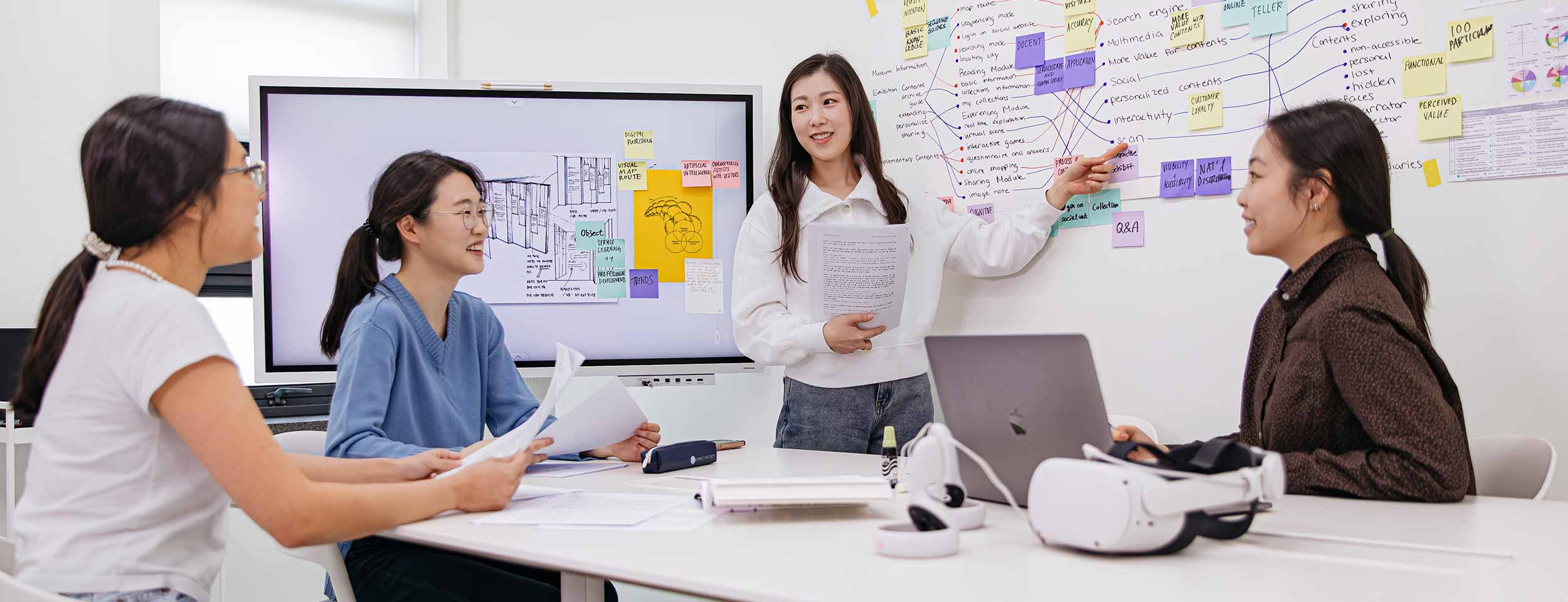
Graduate Programme
The aim of the master’s program in Integrated Design is to create individuals who can contribute to the production and distribution of rapidly evolving design knowledge from a human-centered and integrated design perspective. By participation in a variety of advanced and interdisciplinary courses and research programmes, students in this programme can investigate the potential of new design fields that extend beyond the paradigm of existing design disciplines and research, and develop as autonomous researchers.
Through in-depth study of specialised subjects in communication design, fashion design, product/service design, digital design, and Human Life & Innovation Design, the curriculum of the graduate school of Integrated Design is intended to increase knowledge of human-centered and integrated approaches. It also seeks to promote talented individuals who can work in various design professions.
- Communication Design: Explores strategies, information design, user experience, design methodology, presentation techniques, etc. to effectively communicate messages across various media such as print, digital, space, and new media in various fields such as branding, exhibition, education, entertainment, etc.
- Fashion Design: Explores contemporary fashion design and the fashion industry by examining the representation of personal, social, and cultural values, consciousness of beauty, and technology, and explores the changes in future fashion design and the expansibility of the fashion industry.
- Product/Service Design: Conducts design research on products, services, and systems that generate ecological, social, and economic value and design for sustainable behavior.
- Digital Design: Explores the scientific and expansion of design using new media technologies such as artificial intelligence, VR/AR.
- Innovative Design Major for Human Life: A convergence major operated jointly with the Department of Child and Family Studies in the College of Human Ecology, it aims to cultivate designers to generate social innovation for different stages of human life.
In addition to offering differentiated educational programmes, the graduate school of Integrated Design actively engages in academic research and presentations, seminars that help develop research capabilities, and collaboration projects with a variety of government and corporate entities, providing numerous opportunities for professional researcher development.
Graduate Courses
Major Required (Master's Course)
This course introduces the recent issues and trends in design practice and research. Students will explore design research/projects from integrated design perspective.
The module discusses wide ranges of design research methodologies and critically review research methods used within the subject of human environment design.
Major Required (Ph.D Course)
This course explores the overlap and potential collaboration between design and other academic disciplines (e.g. psychology, business, science, and technology).
The module aims to study the basics of qualitative research and gain understanding of its process through practical practice.
Integrated Courses
It is intended to quantify human sensibility to judge and evaluate qualitatively and use it for design work using engineering techniques, and it learns and understands what emotional engineering is and how it is used in design work.
This module explores future plan for design industry and its challenges from business perspective.
This course is on semiotics theory, which identifies externally represented morphological properties as meaningful symbols in various design fields, and explore real-world examples to empirically study them.
From a design perspective, it is a corporate activity to thoroughly investigate and detect consumers’ needs and reflect them in the development of new products to provide consumers’ desired products to the market and promote sales. This is a change in the market that is subdivided into marketing concepts and studies the concepts and methods of design marketing.
This module offers opportunity to study and gain creative interpretation skills against changing culture. It gives overview of east and west art activities in a chronological order and introduces wide ranges of different perspectives in order for students to gain their own standpoint towards design culture.
This module emphasise the important role of design for interpretating the human living and recreation of culture
This module studies the concept of aesthetics based on philosophical and cultural theories and explores theoretical content for design practice
This module offers opportunity to explore design research methods and study around creative design development and the process.
The module practices planning and analysis around trends under topics related to mega trends and lifestyle
This course introduces various laws related to design, such as the Copyright Act, the Literature Promotion Act, the Environmental Framework Installation Act, the Sales and Distribution Act, and the Art Museum-related Act.
–
This module studies theories of visual merchandising and case studies for consumer product and services
–
This course introduce the color theories and methods to investigate the color for the cultural and industrial insights.
The module explores theories of plastic art through reviewing the case studies from the perspectives of philosophy, aesthetics, and sociology.
This module explore design movements post to modernism and studies on how design has influenced periodic social & cultural attributes, its reciprocal relationship with other disciplines, and changing factors.
Major Elective - Communication Design
Brand design entails planning, organizing, and expressing the personality and the character of a country, a group, or an individual that differentiate from others. Brands continuously transform to cope with the changes in management structures and societal trends. To develop students’ knowledge and ability in identity design, this course guides them in analyzing brand design cases and papers through presentations and discussions, and conducting design projects and research based on a comprehensive review of brand design.
This course focuses on pursuing design research specific to the field of visual design. Students are guided to review quality research papers, discover research topics of individual interest, design appropriate research plans and methods, and execute design research in practice. This course is directed toward promoting students’ ability as academic researchers in the field of visual design.
This course affords the students the opportunity to study and analyze images that function as a language to accurately deliver information. Also, considering recent advancements in media technology, students are encouraged to explore and discuss innovative representation means of sensory language delivered through the five senses as well as ways to objectify and publicize visual language. This course involves analyzing the factors that constitute visual image and practicing the development of visual language from the planning stage to the realization stage with regard to structuring and delivering information.
Identity design is the collection of all elements that expresses the identity of a country, an enterprise, a group, or an individual. It continues to evolve to respond to various changes from being strictly visual to communicating through multisensory channels. This course guides students in presenting and discussing identity design case analyses and in-depth paper reviews and conducting a design project as well as an academic research based on comprehensive analyses on identity design. This course is directed toward promoting students’ ability as identity designers.
This course explores a holistic theories and practice of exhibition design as communication medium. Students will introduce to the exhibition design theories including presentation methods, visitor studies, evaluation methodologies in both physical and virtual exhibition domain. With acquired knowledge, students will propose exhibition communication strategies through visitor studies, exhibition case studies with analysis and evaluation.
This course studies the means to effectively structure, hierarchize, visualize, and systematically deliver information. Innovative information design approaches are explored through empirical studies based on theoretical and conceptual reviews. This course is directed toward promoting students’ competence as experts in information design.
This course involves in-depth research on visualization and specialized representation forms of information with regard to the structure of information, the visual system, and information media. Visual information and their deliverance on various media reflecting the characteristics of the contents, the users, and the media are considered. This course is directed toward reinforcing students’ capacity as information design experts.
This course explores a holistic theories and practice of environmental graphic design such as wayfinding, signage, super graphics both in physical and virtual environment. Through the course, students will propose visual communication design strategies in environment design.
Major Elective - Fashion Design
This course enables the students to explore aesthetics and create designs through case studies on combining art and fashion.
This course explores the expandability of fashion through the adaptation of digital technology for industrial and academic insights.
This course explores the cultural and sematic symbolism of fashion through the comparative analysis of design.
This course explores the various fashion design processes depending on socio-cultural and technological trends.
This course introduces the image analysis methods to investigate the contemporary fashion image.
This course investigates the theoretical basis and the cases of the contemporary fashion illustration to establish the students’ perspective on the artworks.
This course introduces the methods of collaboration and explores the possibility of fashion collaboration through case studies.
–
This course explores the new materials and techniques of fashion accessories based on historical research and case studies
Major Elective - Product/Service Design
This course introduces the whole design process exploring various design process factors and strategies.
–
Students learn the theories and methodologies related to service design, explore new research issues and conduct research through design to develop human-centred services that generate environmental, social and economic values.
This course investigates the theoretical basis and the applications of interactions between human and digital environment. We implement screen-type interaction using digital prototyping tools.
The aim of this module is to help student gain their knowledge and skills around design research, particularly that is oriented for product and service-related design practice. The core learning outcome is to increase your awareness to design research methods and related skills. Teaching activities will allow students to study and develop a depth of knowledge towards building design research methodologies, languages, methods, knowledge and skills necessary for product and service design practices.
–
The module explores and studies around design thinking and its processes; particularly exploring the limitation of user-centred design. Moreover, it offer opportunities to experience and explore more recent and diverse design thinking
Major Elective - Digital Design
This course pursue a hands-on understanding of digital fabrication design paradigm via 3D parametric modelling and 3D printing.
This course introduces the whole design process exploring various design process factors and strategies.
This course introduces state-of-the-art theories and applications of user interface design to approach the field of user interface study from diversified perspectives.
This course explores the design applications of artificial intelligence, particularly deep learning technology, through its software implementation.
This course investigates the theoretical basis and the applications of interactions between human and digital environment. We implement screen-type interaction using digital prototyping tools.
This course is an introduction to generative design methodology, particularly Generative Adversary Network.
We study the theoretical basis and conduct software implementation of GAN applications.
The aim of this module is to help student gain their knowledge and skills around design research, particularly that is oriented for product and service-related design practice. The core learning outcome is to increase your awareness to design research methods and related skills. Teaching activities will allow students to study and develop a depth of knowledge towards building design research methodologies, languages, methods, knowledge and skills necessary for product and service design practices.
–
–
–
–
Major Elective - Innovative Design Major for Human Life
This course aims to integrate knowledge from the child & family studies to understand the characteristics and issues of our developmental stages and explore solutions that respond to these issues using design methodologies.
–
–
–
Lab.

Design for Sustainable Behaviour Lab (DSB)
Design for Sustainable Behaviour, Design for Behaviour Change, Sustainable Product Design, Design for Health & Well-being, Feedback Design, Human-Powered Products
704-1, College of Human Ecology(Samsung Hall), Yonsei University
02-2123-3157
Advisor: Shin Hyun Jae
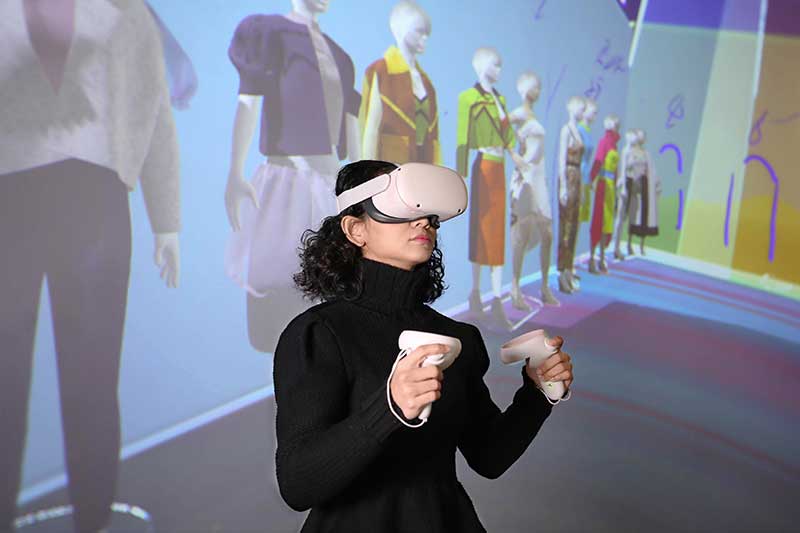
Digital Fashion Design (DFAD) Lab.
Digital fashion design process & methodology (3D Fashion CAD, AR, VR, & 3D Printing), Design cognition & creativity, Fashion collaboration, Future fashion industry & strategy
B126, College of Human Ecology(Samsung Hall), Yonsei University
02-2123-3155
Advisor: Yang Eun Kyoung

Digital Communication+Experience (DC+X) Lab.
UX Design (User Research), Product Design (IA, UI, Design Systems), Digital Service Design (Mobile, VR/XR, AI), Digital Branding, Inclusive, Wellness & Emotional Design
324, College of Human Ecology(Samsung Hall), Yonsei University
02-2123-7904
Advisor: Seung Jin Chung



